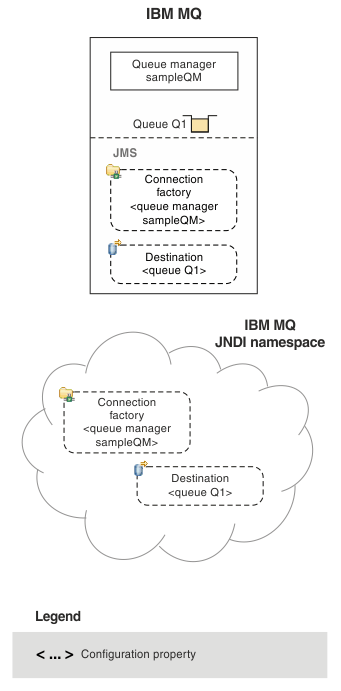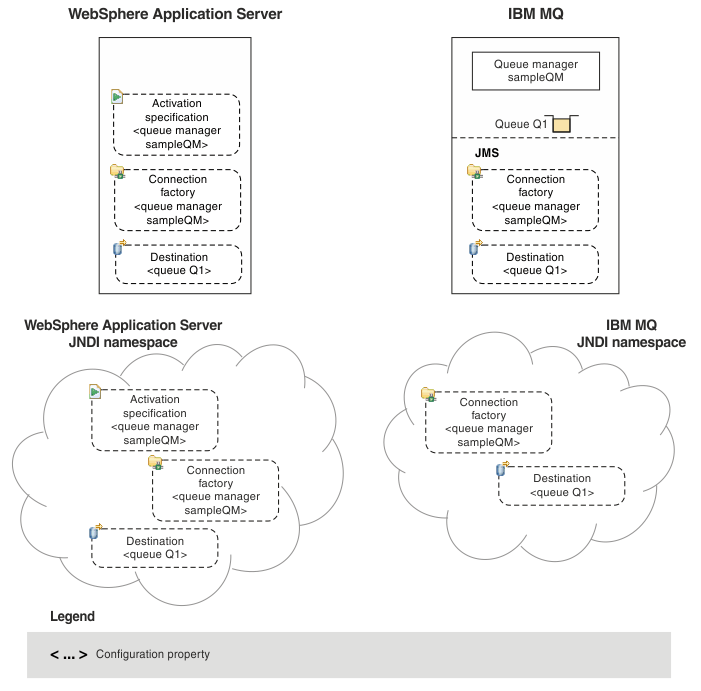Configure connection factories and destinations in a JNDI namespace
JMS applications access administered objects in the naming and directory service through the Java Naming and Directory Interface (JNDI). The JMS administered objects are stored in a location within the naming and directory service that is referred to as the JNDI namespace. A JMS application can look up the administered objects to connect to IBM MQ and access destinations for sending or receiving messages.
About this task
JMS applications look up the names of the JMS objects in the naming and directory service by using contexts:
- Initial context
- The initial context defines the root of the JNDI namespace. For each location in the naming and directory service, we need to specify an initial context to give a starting point from which a JMS application can resolve the names of the administered objects in that location of the naming and directory service.
- Subcontexts
- A context can have one or more subcontexts. A subcontext is a subdivision of a JNDI namespace and can contain administered objects such as connection factories and destinations as well as other subcontexts. A subcontext is not an object in its own right; it is merely an extension of the naming convention for the objects in the subcontext.
We can create contexts using either IBM MQ Explorer or the IBM MQ JMS administration tool. Before an IBM MQ classes for JMS application can retrieve administered objects from a JNDI namespace, we must first create the administered objects using either IBM MQ Explorer or the IBM MQ JMS administration tool. We can create and configure the following types of JMS object:
- Connection factory
- A JMS connection factory object defines a set of standard configuration properties for connections. A JMS application uses a connection factory to create a connection to IBM MQ. We can create a connection factory that is specific to one of the two messaging domains, the point-to-point messaging domain and the publish/subscribe messaging domain. Alternatively, from JMS 1.1, we can create domain-independent connection factories that can be used for both point-to-point and publish/subscribe messaging.
- Destination
- A JMS destination is an object that represents
the target of messages that the client produces and the source of messages that a JMS application consumes. The JMS application can either use a single destination object to
put messages on and to get messages from, or the application can use separate destination objects.
There are two types of destination object:
- JMS queue destination used in point-to-point messaging
- JMS topic destination used in publish/subscribe messaging
The following diagram shows an example of JMS
objects created in an IBM MQ JNDI namespace.
If we use JMS messaging between WebSphere Application Server and IBM MQ, create corresponding objects in WebSphere Application Server to use to communicate with IBM MQ. When you create one of these objects in WebSphere Application Server, it is stored in the WebSphere Application Server JNDI namespace as shown in the following diagram.

If the application uses a message-driven bean (MDB), the connection factory is used for outbound messages only and inbound messages are received by an activation specification. Activation specifications are part of the Java EE Connector Architecture 1.5 (JCA 1.5) standard. JCA 1.5 provides a standard way to integrate JMS providers, such as IBM MQ, with Java EE application servers such as WebSphere Application Server. A JMS activation specification can be associated with one or more message driven beans (MDBs) and provides the configuration necessary for these MDBs to listen for messages arriving at a destination.
We can use either the WebSphere Application Server administrative console or wsadmin scripting commands to create and configure the JMS resources that we need.
Procedure
- To configure JMS objects for IBM MQ using IBM MQ Explorer, see Configure JMS objects using IBM MQ Explorer.
- To configure JMS objects for IBM MQ using the IBM MQ JMS administration tool, see Configure JMS objects using the administration tool.
- To configure JMS objects for WebSphere Application Server, see Configure JMS resources in WebSphere Application Server.
Results
An IBM MQ classes for JMS application can retrieve the administered objects from the JNDI namespace and, if required, set or change one or more of its properties by using either the IBM JMS extensions or the IBM MQ JMS extensions.
Parent topic: Configure JMS resourcesRelated information
- Use JNDI to retrieve administered objects in a JMS application
- Create and configure connection factories and destinations in an IBM MQ classes for JMS application